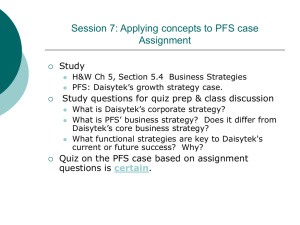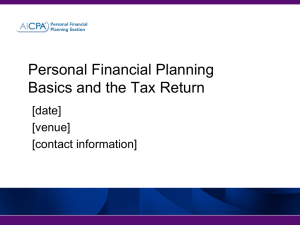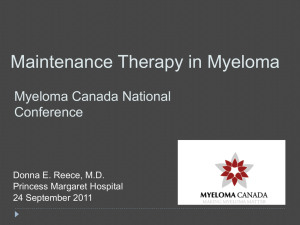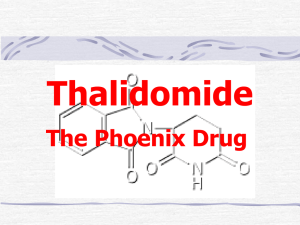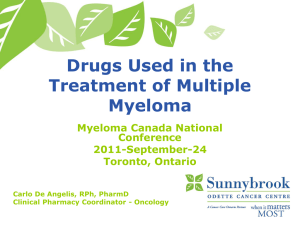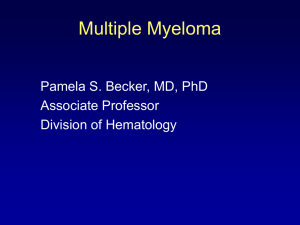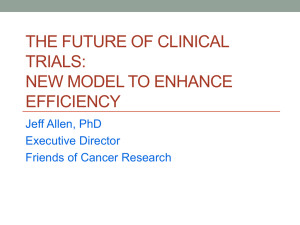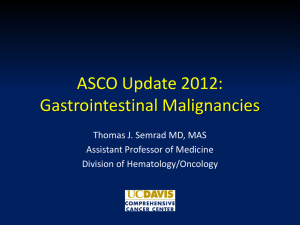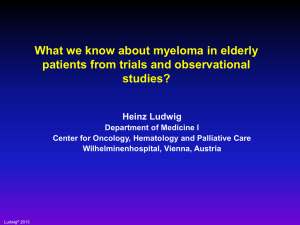Maintenance
advertisement
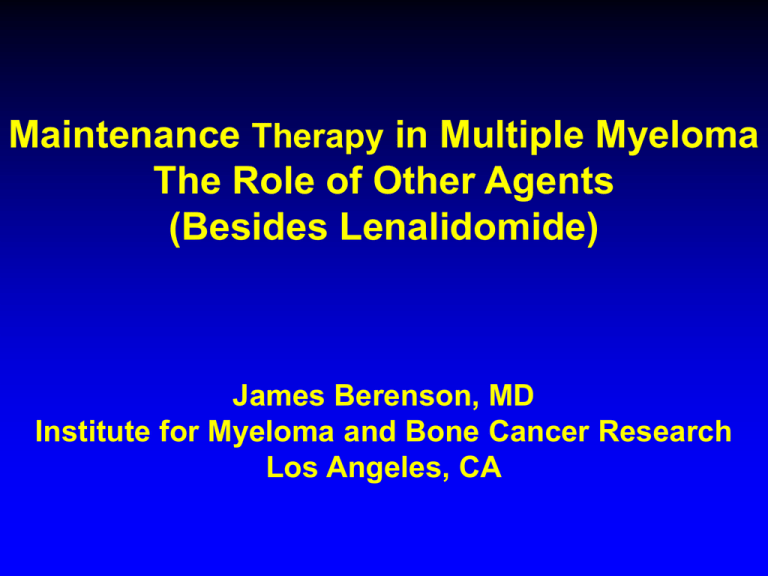
Maintenance Therapy in Multiple Myeloma The Role of Other Agents (Besides Lenalidomide) James Berenson, MD Institute for Myeloma and Bone Cancer Research Los Angeles, CA Maintenance Therapy in Myeloma Goals Reduce the risk of relapse Extend PFS and OS Maintain response achieved following a new treatment with administration of drugs for a prolonged time period Therapy must be Convenient Safe and well tolerated LONGTERM NOT prevent use or reduce efficacy of other future treatments Maintenance Therapy in Myeloma In what setting- frontline or > 2nd line Most of the data is in the frontline setting How long to “maintain” maintenance therapy Until relapse or for a fixed length of time Trials have employed both approaches BUT no randomized trials comparing the two w/i a trial Which agents How many to use? Doses? Schedule(s)? Very little data from randomized trials comparing different maintenance regimens as the only randomization Maintenance Therapy in Myeloma: Steroids and a-Interferon 1. a-Interferon: a. 929 patients in 8 trials had prolongation of remission duration and survival by 6 and 5 months Ludwig H. Ann Oncol 1995;467 b. Twist analysis: IFN gained 9.8 months without relapse and 5.8 months survival, but with 4.1 months of toxicity Therefore, benefits must be balanced against toxicity Ludwig H. 1997;1672 2. Prednisone 50 mg qod prolongs overall and event-free survival after VAD induction therapy Berenson J. Blood 2002;99:3163 Thalidomide: Maintenance Therapy after Autologous Stem Cell Transplant N Initial dose, mg/d Attal et al.1 597 Barlogie et al.2 668 400 Spencer et al.3 243 200 w/ steroid vs steroid alone Lokhorst et al.4 535 50 1. 3. 400 w/ PAM vs PAM or none Attal M, et al. Blood. 2006 Spencer A, et al. J clin Oncol. 2009 Maintenance versus no maintenance CR, % EFS or PFS, % OS, % 67 vs 55* 3-year EFS 52 vs 36 4-year OS 87 vs 77 62 vs 43 5-year EFS 56 vs 44 8-year OS 57 vs 44 3-year PFS 42 vs 23 3-year OS 86 vs 75 Median 22 m vs 34 m Median 60 m vs 73 m 63 vs 40* 24 vs 66* 2. 4. Barlogie B, et al. Blood 2008 Lokhorst et al . Blood 2010 * CR + VGPR rates. Bisphosphonates: Anti-Tumor Effects in MM Direct Induces apoptosis Prevents prenylation of GTPases Indirect Reduces anti-apoptotic and growth factors Anti-angiogenic Decreases angiogenic factors Prevents endothelial cell development Inhibits angioattraction M2 to M1 reversion of TAMs Prevents adhesion of MM cells to stroma Synergizes w/ other anti-MM drugs Immune stimulatory effectsIncreases Vg9d2 T cells Pamidronate With or Without Thalidomide as Post-transplantation Maintenance Therapy • Intergroupe Francophone du Myeloma (IFM) 99 02 – Large, randomized, prospective study No maintenance therapy (n = 200) Pts with untreated Stage I - III MM < 65 yrs old (N = 780) VAD regimen 3-4 cycles Melphalan 140 mg/m2 and autologous stem-cell transplant Melphalan 200 mg/m2 and second autologous stem-cell transplant Pts who did not progress after 2 mos (n = 597) VAD; vincristine, doxorubicin, and dexamethasone Pamidronate (90 mg/mo) (n = 196) Pamidronate (90 mg/mo) + Thalidomide (100 mg/day) (n = 201) Survival benefit in the combination PAM + Thal arm and not in the single agent PAM arm Attal M et al Blood 2006; 108: 3289. MRC Myeloma IX: Trial Design for Monthly IV Zoledronic Acid vs Daily Oral Clodronate for Newly Diagnosed MM N = 1,960 Patients with newly diagnosed MM (stage I, II, III) • R A N D O M I Z A T I O N Zoledronic acid (4 mga IV q 3-4 wk) + intensive or non-intensive chemotherapy (n = 981) Treatment continued at least until disease progression Clodronate (1600 mg/d PO) + intensive or non-intensive chemotherapy (n = 979) Endpoints (ZOL vs CLO) – Primary: PFS, OS, and ORR – Secondary: Time to first SRE, SRE incidence, and safety Abbreviations: CLO, clodronate; IV, intravenous; MM, multiple myeloma; ORR, overall response rate; OS, overall survival, PFS, progression-free survival; PO, oral; SRE, skeletal-related event; ZOL, zoledronic acid. a Dose-adjusted for patients with impaired renal function, per the prescribing information. Morgan G, et al. Lancet. 2010;376:1989-1999. MRC Myeloma IX: ZOL Improved OS and PFS vs CLOa • ZOL significantly reduced the relative risk of death by 16% vs CLO (HR = 0.842; 95% CI = 0.736, 0.963; P = .0118) 0.883 PFS 0.2 0.4 16% .0118 12% .0179 0.6 0.8 1 1.2 1.4 1.6 Hazard ratio (ZOL versus CLO) In favor of ZOL a P value 0.842 OS 0 Risk reduction 1.8 2 In favor of CLO Cox model adjusted for chemotherapy, and minimization factors. Morgan G, et al. Lancet. 2010;376:1989-1999. Bortezomib as Maintenance Therapy VMPT-VT vs VMP: Study Design NDMM (N=511) SCT-ineligible Measurable disease Karnofsky PS ≥60% R A N D O M I Z E VMPT (n=254) Induction: 9 courses Weekly BORT (4 doses; 1.3 mg/m2) Melphalan 9 mg/m2 Prednisone 60 mg/m2 once daily on days 1-4 of each course Thalidomide 50 mg/day continuously VMP (n=257) 9 courses Weekly BORT (4 doses; 1.3 mg/m2) Melphalan 9 mg/m2 Prednisone 60 mg/m2 once daily on days 1-4 of each course Endpoints: – Primary: PFS Secondary: RR, OS, and grade ≥3 AEs – Palumbo A, et al. Presented at: ASH. 2012 (abstr 200). VT (n=254) Maintenance: 2 years BORT 1.3 mg/m2 or maximum dose tolerated q2w Thalidomide 50 mg/day continuously No Maintenance Therapy (N=257) 10 VMPT-VT vs VMP: PFS and Time to Next Therapy (TTNT) Median PFS, Months Median TTNT, Months VMPT-VT 35.3 46.6 VMP 24.8 27.8 42 (of progression) 48 (of next therapy) Reduced risk, % Median follow-up 54 months PFS 1.00 HR: 0.58 (95% CI, 0.47-0.71); P<0.0001 0.75 HR: 0.52 (95% CI, 0.42-0.66); P<0.0001 0.75 Patients, % Patients, % TTNT 1.00 VMPT-VT 0.50 VMP VMP 0.25 0.25 0.00 0.00 0 10 20 30 40 50 Time, Months 60 TTNT=time to next therapy. Palumbo A, et al. Presented at: ASH. 2012 (abstr 200). 70 80 VMPT-VT 0.50 0 10 20 30 40 50 Time, Months 60 70 80 11 VMPT-VT vs VMP: Overall Survival Induction Maintenance Proportion of Patients 1.00 0.75 VMPT-VT 0.50 VMP 0.25 HR: 0.74 (95% CI, 0.55-0.99); P=0.04 0.00 0 10 20 30 40 50 60 70 80 Time, Months Efficacy, % VcMPT-VcT VcMP P Value 5-yr PFS 29 13 <0.0001 5-yr TTNT 41 19 <0.0001 5-yr OS 61 51 0.01 3-yr OS from relapse 47 46 0.63 Palumbo A, et al. Presented at: ASH. 2012 (abstr 200). 12 Impact of Maintenance Therapy: VMPT-VT vs VMP Landmark analysis after finishing 9 cycles of induction VMPT or VMP •52% reduced risk of progression with VMPT-VT (HR 0.48, P<0.0001) – Irrespective of response (CR or PR) – In pts <75 yrs old, but not ≥75 yrs •Prognostic factors: response, age, ISS, cytogenetic abnormalities Grade 3/4 AE’s during maintenance VMPT-VT Hematologic 2% DVT 1% Sensory neuropathy 6% Infection 1% Cardiologic 1% Discont. due to AE 11% Palumbo et al. ASH 2010 (Abstract 620) HOVON-65/GMMG-HD4: Study Design Multicenter, International, Phase III Trial Patients 18-65 years of age with newly diagnosed stage II/III MM (N=744) PAD × 3 cycles BORT 1.3 mg/m2 days 1, 4, 8, 11 doxorubicin 9 mg/m2days 1-4 dexamethasone 40 mg days 1-4, 9-12, 17-20 (n=371) Stem cell collection and transplantation* BORT 1.3 mg/m2 every 2 weeks 2 years VAD × 3 cycles Vincristine 0.4 mg days 1-4 Doxorubicin 9 mg/m2 days 1-4 Dexamethasone 40 mg days 1-4, 9-12, 17-20 (n=373) Stem cell collection and transplantation* • Primary endpoint: PFS • Secondary endpoints: response, OS, toxicity *ASCT + melphalan 200 mg/m2; allogeneic SCT with no maintenance offered when possible; German patients enrolled through GMMG underwent 2 ASCTs. German centers performed double SCT; Dutch centers performed single SCT. Sonneveld P, et al. J Clin Oncol. 2012;30:2946-2955 Thalidomide 50 mg/day HOVON-65/GMMG-HD4: Response, PFS & OS PFS 80 80 60 60 40 PAD VAD 20 OS 100 OS, % PFS, % 100 P=0.002 40 PAD VAD 20 P=0.07 0 0 0 12 24 36 48 Time, Months 60 0 12 24 36 48 60 Time, Months Improved PFS and OS in pts w/ del 17p13 and those w/ creatinine > 2 mg/dL Response VAD Arm: Thalidomide, % (n=414) PAD Arm: BORT, % (n=413) Pand t Value 24 34 56 83 36 49 76 90 <0.001 <0.001 <0.001 0.002 CR ≥ nCR ≥ VGPR ≥ PR Sonneveld P, et al. J Clin Oncol. 2012;30:2946-2955 Phase III PETHEMA/GEM Trial: Bortezomib as Maintenance Therapy in Previously Untreated MM1,2 • Endpoints: Primary: PFS; Secondary: response rate, OS, safety • Patients: 266 pts <65 yrs of age with previously untreated MM randomized to • maintenance therapy; median age 56–58 yrs across arms; 53–59% ISS stage II/III across arms Dose and schedule: Induction: thalidomide/Dex (6 cycles) vs VTD (6 cycles) vs VBMCP/VBAD (4 cycles) + bortezomib (2 cycles); followed by ASCT with MEL-200; then second randomization to: Maintenance: 3 arms • • • bortezomib 1.3 mg/m2 days 1, 4, 8, 11 every 3 mos + thalidomide 100 mg/day (VT) thalidomide 100 mg/day interferon-α2b 3 MU 3 times/week; for 3 yrs • Response: Maintenance VT (n=89) Maintenance thalidomide (n=87) Maintenance interferon (n=90) 49 11 37 53 13 33 63 15 69 15 Response before maintenance, % CR VGPR PR 53 12 33 Response improvement with maintenance, % CR post-maintenance Increase in CR 74 21 Rosiñol L, et al. ASH 2012, abstract #334; Induction phase publication: Rosiñol L, et al. Blood 2012;120:1589-1596; Maintenance therapy previous publication: Rosiñol L, et al. ASH 2011, abstract #3962 Phase III PETHEMA/GEM Trial: Bortezomib as Maintenance Therapy for Previously Untreated MM1,2 • Outcomes: Median follow-up of 34.9 mos; from onset of maintenance therapy: PFS: addition of bortezomib to thalidomide (VT) maintenance resulted in significantly longer PFS vs thalidomide or interferon (p=0.0009) OS: No difference between arms (p=0.47) Bortezomib-containing (VT) maintenance conferred a significant PFS advantage in pts with low-risk (p=0.002) but not high-risk (p=0.5) cytogenetics • Safety: Gr 3/4 thrombocytopenia for VT vs. thalidomide: 10% vs. 2%; p=0.01 Gr 3/4 neutropenia: Approximately 13% for VT, 16% for thalidomide, and 17% for interferon *p=0.02 vs thalidomide; #p=0.06 vs thalidomide; †discontinued thalidomide but remained on bortezomib Rosiñol L, et al. ASH 2012, abstract #334 Phase III: VMP vs VTP in Newly Diagnosed Elderly Pts with MM (PETHEMA/GEM Study) • Pts (n=260), >65 yrs old (median age 73 yrs) • Multicenter, two-stage randomized trial Induction Randomization step 1 Induction (max. 6 cycles) • One 6-wk cycle, bortezomib 2x wkly • Five 5-wk cycles, bortezomib 1x wkly VMP vs VTP Maintenance Randomization step 2 Maintenance (up to 3 yrs) Bortezomib: 1.3 mg/m2 (d 1, 4, 8, 11), every 3 mos + Thal: 50 mg daily (VT) VT vs VP VT vs VP or Pred: 50 mg every 48 hrs (VP) Mateos et al. Lancet Oncol 2010; 11(10): 934-941 PFS and OS • No significant difference in PFS and OS between VMP and VTP groups and not significantly different for VT or VP maintenance PFS OS VMP 3-yr OS 74% VMP 34 mos VTP 3-yr OS 65% p=0.1 VTP 25 mos p=0.3 Mateos et al. Lancet Oncol 2010; 11(10): 934-941 Summary The role of maintenance therapy with novel agents has not been clearly defined (limitations in trial designs) Long term use appears to be safe w/ bortezomib and steroids Better trial designs are required to clarify the role of maintenance therapy in myeloma Specific drugs Single agent vs combination Doses and schedules Length of therapy- fixed vs to progression Endpoints- PFS vs OS In Our Clinical Practice Maintenance therapy is used for all patients responding in both the frontline and salvage settings Drugs are continued until progressive disease; however, doses may have to be reduced or discontinued due to toxicity Drugs are continued that were part of the treatment regimen EXCEPT chemotherapy New agents are NOT introduced during maintenance (i.e. the devil you know is better (and shown to be effective) than the one you don’t)- if so, this is NEW treatment Steroids at equivalent dose intensity (160 mg Dex)/month as oral methylprednisolone qod alone or w/ IV Dex qow Bortezomib 1.3 mg/m2 sc qow IMiD drugs- Lenalidomide 10 mg for 14 or 21 days depending on regimen; THAL 50-100 mg daily and tapered w/ neuropathy Zoledronic acid is continued monthly
